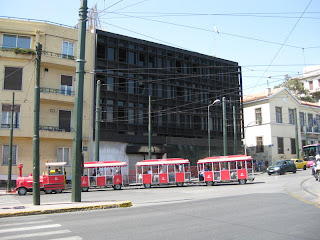 This week's economic schedule includes a second look at GDP, a wishful check of jobs and Treasury Secretary Timothy Geithner's Asia/ Europe tour. Can't miss news also includes the Personal Income & Outlays data and investor and consumer confidence measures. Finally, several Greek banks report earnings this week, potentially raising concern about the state of Europe's banking system."The Greek" earned clients a 23% average annual return over five years as a stock analyst on Wall Street. While writing for Wall Street Greek and others, he presciently predicted the financial crisis and housing and banking failures of the Great Recession. Visit the front pages of Wall Street Greek now to see our current coverage of business news, global financial markets, real estate, shipping, fine art, technical analysis and global affairs.
This week's economic schedule includes a second look at GDP, a wishful check of jobs and Treasury Secretary Timothy Geithner's Asia/ Europe tour. Can't miss news also includes the Personal Income & Outlays data and investor and consumer confidence measures. Finally, several Greek banks report earnings this week, potentially raising concern about the state of Europe's banking system."The Greek" earned clients a 23% average annual return over five years as a stock analyst on Wall Street. While writing for Wall Street Greek and others, he presciently predicted the financial crisis and housing and banking failures of the Great Recession. Visit the front pages of Wall Street Greek now to see our current coverage of business news, global financial markets, real estate, shipping, fine art, technical analysis and global affairs.(Tickers: NYSE: DIA, NYSE: SPY, Nasdaq: QQQQ, NYSE: DOG, NYSE: SDS, NYSE: QLD, NYSE: NYX, Nasdaq: NDAQ, NYSE: ICE)
Greek Banks Report Results This Week

With the National Bank of Greece, Marfin Popular Bank, Alpha and ATE all reporting results this week, Greece and Europe might go back into spin cycle. Back Stateside, we will get another look at first quarter GDP, but the market will be more concerned with Personal Outlays data.
MondayOverseas news should start the day's trade at home Monday. Federal Reserve Chairman Bernanke and Treasury Secretary Geithner are in China for high level economic talks. Let's hope they did not take their laptops... Markets are closed in Canada, Switzerland, Greece and a few others.
Back home in the good old USA, the Securities and Exchange Commission (SEC) and the US Commodity Futures Trading Commission (CFTC) examine May 6th's "flash crash" and offer suggestions on how to avoid a recurrence.
At 10:00 AM, look for April's
Existing Home Sales data. Barron's says economists are looking for an April gain, due to the expiring First-Time Homebuyers Tax Credit. Bloomberg's survey of economists seems to concur, as the consensus forecasts the annual pace of sales will have improved to 5.6 million, versus March's 5.35 million sales pace.
April's end only marked the deadline to enter into contract for a home sale though, while Existing Home Sales measures sales closures. The deadline for closure comes in June. Therefore, while there may be some rise in April's data, I expect gains to continue to show themselves in the next few months' data.
Sony (NYSE: SNE) and Samsung (OTC: SSNLF.PK) CEOs are scheduled to meet. Analysts meetings are scheduled for BHP Billiton (NYSE: BHP), Petrohawk Energy (NYSE: HK) and Harris (NYSE: HRS). Earnings are due for American Metal & Technology (Nasdaq: AMGY), Angeion (Nasdaq: ANGN), Campbell Soup (NYSE: CPB), China Shenghuo Pharma (AMEX: KUN), ChinaEdu (Nasdaq: CEDU), Document Capture Technologies (Nasdaq: DCMT), Donaldson (NYSE: DCI), Eastern Light Capital (AMEX: ELC), Flint Telecom Group (Nasdaq: FLTT), Gladstone Investments (Nasdaq: GAIN), Image Metrics (Nasdaq: IMGX), ImaRx Therapeutics (Nasdaq: IMRX), Internet Gold (Nasdaq: IGLD), Invensys (OTC: IVNSY.PK), Lattice (Nasdaq: LTTC), Longtop Fin'l Tech (NYSE: LFT), Manhattan Pharma (Nasdaq: MHAN), Orsus Xelent Tech (AMEX: ORS), PHI Group (Nasdaq: PHIE), Phillips Van-Heusen (NYSE: PVH), Radient Pharma (AMEX: RPC), Senetek plc (OTC: SNTKY.PK), Top Image Systems (Nasdaq: TISA), UQM Tech (AMEX: UQM), Vermillion (Nasdaq: VRML) and Yingli Green Energy (NYSE: YGE).
TuesdayThe data day will start overseas again, with Fed Chairman Bernanke addressing a Tokyo grouping on central bank accountability.
It will be interesting to see this week's data from the
International Council of Shopping Centers (ICSC). Last week's report, covering the week ended May 15, showed a sharp downturn in sales that was attributed to cold weather. Week-to-week sales fell 2.5% in the period, and year-over-year growth moderated sharply to 2.9%. This week's data should provide verification of whether it was a one-time non-recurring factor that stalled activity, or whether there's cause for concern.
At 9:00 a.m., S&P Case Shiller produces its
Home Price Index for the month of March. February's data showed continued year-over-year price appreciation, as the 10-city index saw prices edge higher by 1.5% on an adjusted basis. However, over the last two periods measured, price recovery has come back into question. The 10-city seasonally adjusted index posted a 0.1% sales rise in February, but fell 0.6% when excluding the adjustment. Given recent stock market alarms and overseas worries, alongside ongoing unemployment in the States, some experts are pointing toward a second drop in prices of perhaps 10%. I have to concur that with the First-Time Homebuyers Tax Credit being pulled, and the environment still soft, price decline seems highly possible in the months ahead. In a previous article, I noted that the trend line seemed to indicate that normalized price levels might be a bit lower - while support could hold here. That said, continued population growth and reduced inventory levels (ex-shadow inventory of lender occupied foreclosure properties) have our real estate expert looking to the current market as a buying opportunity.
The
FHFA House Price Index is due Tuesday as well, at 10:00 a.m. Both of these data tenders look too far back to be of much use, and so I like to pay attention to the National Association of Realtors data. The NAR reported Monday that home prices rose across a majority of its markets. In fact, the median price of an
existing home rose 4% in
April (this is relevant), matched against the prior year count. FHFA's data only measures homes with mortgages purchased or securitized by Fannie Mae (NYSE: FNM) or Freddie Mac (NYSE: FRE); while that was once a big portion of the nation's mortgages, it's still important.
At 10:00 a.m., the Conference Board will report on
Consumer Confidence. The measure of consumer sentiment recovered in April, after an early year slip. However, given recent global market meltdown, there's a chance economists could be wrong with their consensus forecast for a gain to 59.0 (based on Bloomberg's survey). April's watermark is 57.9.
Also at 10:00 a.m., look for State Street's (NYSE: STT)
Investor Confidence Index for the month of May. Not surprisingly, April's report recorded a drop in investor confidence sparked by the contagious affects of Europe on North American and Asian investors. April's index fell below the 100 break-point, sitting at 99.7, versus March's revised 107.4. A measure below 100 signifies a general aversion to risk.
The US House of Representatives votes on a plan to raise taxes on investment management companies. This is the kind of thing that makes me miss Ronald Reagan. St. Louis Federal Reserve Bank President James Bullard gives a speech on "The Road to Economic Recovery Following the Financial Crisis," to the European Economics and Financial Centre in London.
On the corporate slate, share-offering lock-up periods conclude for China Advanced Construction Materials (Nasdaq: CADC), Owens Corning (NYSE: OC) and Penn Virginia (NYSE: PVA). Catch the analyst meetings at Flextronics (Nasdaq: FLEX), McAfee (NYSE: MFE) and Petrobras (NYSE: PZE). The day's earnings schedule includes reports from AutoZone (NYSE: AZO), Convio (Nasdaq: CNVO), Cracker Barrel Old Country Store (Nasdaq: CBRL), DSW, Inc. (NYSE: DSW), Dycom Industries (NYSE: DY), Flowers Foods (NYSE: FLO), HEICO (NYSE: HEI), Israel Chemicals (OTC: ISCHF.PK), Ituran Location & Control (Nasdaq: ITRN), Ixys Corp. (Nasdaq: IXYS), Medtronic (NYSE: MDT), Netezza (NYSE: NZ), Palm Harbor Homes (Nasdaq: PHHM), Partner Communications (Nasdaq: PTNR), Pointer Telocation (Nasdaq: PNTR), Salary.com (Nasdaq: SLRY), Sanderson Farms (Nasdaq: SAFM), Shiloh Industries (Nasdaq: SHLO), Sociedad Quimica y Minera S.A. (NYSE: SQM), TIVO, Inc. (Nasdaq: TIVO), Tivoli (Nasdaq: TVLI), Trina Solar (NYSE: TSL), TTI Telecom (Nasdaq: TTIL) and WSP Holdings (NYSE: WH).
WednesdayTreasury Secretary Timothy Geithner stops over in London before returning from Asia. He will be doing his best to restore European market confidence. Keeping with international happenings, the Organization for Economic Co-operation and Development (OECD) publishes its economic outlook. Back home, the SEC might propose a new rule for audit trails on all securities.
In the pre-market, look for the regular
mortgage activity report from the Mortgage Bankers Association. Last week's data, covering the period ended May 14, produced a sharp dropoff in activity. The Market Composite Index decreased 1.5%, but the headline index does not tell the whole story. Long rates collapsed as interest intensified for US Treasury securities (on European demise). Average contracted rates on 30-year and 15-year fixed rate mortgages fell to 4.83% (from 4.96%) and 4.19% (from 4.32%), respectively. As a result, the Refinance Index increased 14.5%.
The big news was found in the Purchase Index, which collapsed 27.1% to the lowest level since May of 1997. This is where you can see the impact of the concluding tax incentive. The MBA theorized that the incentive pulled activity from May into April. The big question is, what will happen after a few weeks pass, and the tax incentive plays no role whatsoever?
Durable Goods Orders are due for the month of April at 8:30. Given decent April numbers out of ISM, and the New York and Philly Feds, economists are forecasting more growth in Durables for April. February Durables rose 3.7% in March when excluding transportation, and that followed a February gain of 2.1% ex-transportation. Economists forecast durables rose 1.5% in April.
New Home Sales will be reported for April at 10:00 AM. March sales increased 26.9% ahead of the deadline for tax incentive. April sales are forecast to gain as well, to an annual pace of 425K, versus March's rate of 411K.
The EIA reports on
Petroleum Status at 10:30 AM. Last week's report for the period ending May 14, showed crude oil inventory rose by 0.2 million barrels. Total motor gasoline stocks decreased by 0.3 million barrels, but both crude oil and gasoline remained above the upper limit of the average range for this time of year.
At 4:15 PM, Richmond Federal Reserve Bank President Jeffrey Lacker will speak on the topic of financial regulation at a conference at the Institute for International Economic Policy in Washington.
In corporate news, analysts meetings are scheduled for Newell Rubbermaid (NYSE: NWL), Arrow Electronics (NYSE: ARW), Thermo Fisher Scientific (NYSE: TMO), Northern Trust (Nasdaq: NTRS), and Yahoo! (Nasdaq: YHOO). The National Bank of Greece (NYSE: NBG) reports earnings results today. The Ira Sohn investment conference kicks off in New York, while Finra starts its annual conference. Trade lockup curbs expire on ArvinMeritor (NYSE: ARM), while Tessco (Nasdaq: TESS) splits 3:2.
The day's earnings schedule includes 99 Cents Only (NYSE: NDN), AFC Enterprises (Nasdaq: AFCE), American Eagle Outfitters (NYSE: AEO), Apollo Investment Corp. (Nasdaq: AINV), Avago Tech (Nasdaq: AVGO), Bank of Montreal (NYSE: BMO), BluePhoenix Solutions (Nasdaq: BPHX), Brown Shoe Co. (NYSE: BWS), Charm Communications (Nasdaq: CHRM), Codexis (Nasdaq: CDXS), Diana Shipping (NYSE: DSX), Dress Barn (Nasdaq: DBRN), Fred's (Nasdaq: FRED), Hoku Scientific (Nasdaq: HOKU), Jamba Juice (Nasdaq: JMBA), Jo-Ann Stores (NYSE: JAS), LTX-Credence (Nasdaq: LTXC), NetApp (Nasdaq: NTAP), Rosetta Genomics (Nasdaq: ROSG), Rue21 (Nasdaq: RUE), Semtech (Nasdaq: SMTC), Sigma Designs (Nasdaq: SIGM), Solarfun Power (Nasdaq: SOLF), Sycamore Networks (Nasdaq: SCMR), Synovis Life Tech (Nasdaq: SYNO), Telvent (Nasdaq: TLVT), Toll Brothers (NYSE: TOL), Trintech (Nasdaq: TTPA), VeriFone Holdings (NYSE: PAY), Vimpel-Communications (NYSE: VIP) and Zale Corp. (NYSE: ZLC).
ThursdayTim Geithner remains in Europe to consult with the Europeans on the debt crisis. Meanwhile, back home, a House Oversight panel reviews Johnson & Johnson's (NYSE: JNJ) childrens' Tylenol recall.
Weekly Jobless Claims are due as usual at 8:30 AM Thursday. For the week ended May 15, Jobless Claims jumped 25K, to 471K, ringing alarm bells across Wall Street. Things are just not getting better for the labor market and it's hard to ignore at this point, with jobs bleeding away week to week.
When last reported on April 30,
first quarter GDP came in at +3.2%, down from Q4's growth rate of 5.6%. In this "preliminary" report, following the "advance" report, economists expect an upward revision to 3.5% (makes sense to me due to Easter, and could be better than this). The hope is that the upward adjustment will be driven by a fix to sales, not prices. The Price Index is seen increasing 0.9%, like it was reported the first time. Corporate Profits data is reported simultaneously.
For the week ended May 14, the EIA reported
natural gas stocks increased by 76 Bcf. Inventory stood at 308 Bcf above the five-year average for this time of year, placing it also above the upper limit of the average range.
Golden Network's High-Frequency Trading Forum takes place in New York. Investor meetings are scheduled at Newmont Mining (NYSE: NEM) and Heinz (NYSE: HNZ). Edward's Lifesciences (NYSE: EW) splits 2 for 1. Corporate EPS releases arrive from Costco (Nasdaq: COST), Alpha Bank (ATHENS: ALPHA.AT), ATE Bank (ATHENS: ATE.AT), Big Lots (NYSE: BIG), Bio-Reference Labs (Nasdaq: BRLI), Blue Coat Systems (Nasdaq: BCSI), Borders Group (NYSE: BGP), Canadian Imperial Bank of Commerce (NYSE: CM), Columbus McKinnon (Nasdaq: CMCO), Concord Medical Services (NYSE: CCM), Conn's (Nasdaq: CONN), dELiA's Inc. (Nasdaq: DLIA), Diamond Foods (Nasdaq: DMND), Ditech Networks (Nasdaq: DITC), Esterline Tech (NYSE: ESL), FreeSeas (Nasdaq: FREE), Genesco (NYSE: GCO), GigaMedia (Nasdaq: GIGM), Guess (NYSE: GES), H.H. Gregg Appliances (NYSE: HGG), J. Crew (NYSE: JCG), Jackson Hewitt Tax Service (NYSE: JTX), Jade Art (Nasdaq: JADA), Magma Design Automation (Nasdaq: LAVA), Marfin Popular Bank (Frankfurt: JXG.F), Monro Muffler (Nasdaq: MNRO), Movado (NYSE: MOV), Navios Maritime (NYSE: NM), Ninetowns Internet Tech (Nasdaq: NINE), Novell (Nasdaq: NOVL), Omnivision Technologies (Nasdaq: OVTI), QAD (Nasdaq: QADI), Quanex Building Products (NYSE: NX), REX Stores (NYSE: RSC), Royal Bank of Canada (NYSE: RY), SeaChange Int'l (Nasdaq: SEAC), Signet Jewelers (NYSE: SIG), Tate & Lyle (OTC: TATYY), Toronto Dominion Bank (NYSE: TD), Terremark Worldwide (Nasdaq: TMRK), Uroplasty (AMEX: UPI), Versant (Nasdaq: VSNT), XETA Tech (Nasdaq: XETA) and Zarlink Semi (OTC: ZARLF.PK).
FridayUnlike last week, Friday is littered with economic reports you might miss as you prepare for the long weekend. Leading off in the pre-market, look for the
Personal Income and Outlays Report for April at 8:30. All signs are for a more moderate pace of Consumer Spending in April, given the Easter impact on other economic measuring sticks. However, Retail Sales were relatively solid in April across most categories. Economists peg consumer spending at +0.2% for April, and the figure looks Kosher to us as well. March's consumer spending measured +0.6%.
Personal Income is seen increasing 0.5%, versus the 0.3% month-to-month increase in March. The gain in March came mostly in the service sector, and may have benefited from tax filing preparations and even census activity. Since that was likely the case, a similarly robust increase might be expected in April as well. Get this, emergency unemployment insurance boosted the "other" category by $12 billion (annually adjusted).
At last reading, Midwestern business activity was gaining robustly. We will get the latest look at the
Chicago Purchasing Managers Index Friday morning at 9:45 AM. April's reading of the index gained to its highest mark since April 2005. The index rose five points to 63.8, and was characterized by broad gains. Even employment marked its fourth month of growth, while Order Backlogs and Supplier Deliveries neared ten-year highs. However, Prices Paid also accelerated to their highest level since September 2008. You know we are watching this!
Given the recent moderation of expansion in New York and Philly, we might expect Chicago's May reading to slip a bit. However, the Chicago PMI measures both manufacturing and non-manufacturing, and so is not perfectly comparable. Economists do still expect the pace of expansion to moderate a bit to 62.0 in May.
Consumer Sentiment will be reported at 9:55 AM. The Reuters/University of Michigan measure comes days after the Conference Board's Report and so expectations should be swayed by that result. The feeling is that ongoing unemployment and the recent test to stocks could skew this latest measure of consumer mood lower. Economists forecast the end of May measurement will stick at 73.3, the same as at mid-month.
The Department of Energy review of the Deepwater Horizon oil spill is due today. At 3:00 PM, look for the Department of Agriculture's Farm Prices data. Ahead of the Memorial Day holiday, the bond market will close at 2 PM EST.
Canadian Natural Resources (NYSE: CNQ) will split 2:1 at the market close. EPS reports include Golar LNG Ltd. (Nasdaq: GLNG), Industrie Natuzzi (NYSE: NTZ) and Quality Systems (Nasdaq: QSII).
 Please see our disclosures at the Wall Street Greek website and author bio pages found there. This article and website in no way offers or represents financial or investment advice. Information is provided for entertainment purposes only.
Please see our disclosures at the Wall Street Greek website and author bio pages found there. This article and website in no way offers or represents financial or investment advice. Information is provided for entertainment purposes only.





































